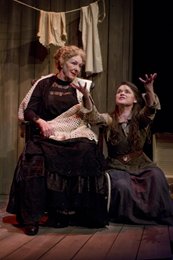There’s a quote from Carl G Jung that goes like this: "Where love rules, there is no will to power, and where power predominates, love is lacking." In The Goddess of Liberty, this power struggle is centred around the physical and mental disability of the central character, Frankie (Geraldine Plunkett). Due to stroke, the formerly vibrant and dominating woman is relegated to a wheelchair, and her disability changes the playing field for all the relationships in the play, loving and otherwise. Yet, despite this theme seeming to be central, the play doesn’t seem to focus on it enough – to the detriment of an interesting and often lyrical text.
 That the disability causes feelings of discomfort in the viewers is, of course, absolutely correct. Watching Plunkett attempt to communicate is disturbing and in the beginning, it is almost a relief that the stories of the others in the play – of Frankie’s devoted friend and dresser May (Máire Ní Ghráinne), her daughter T-Belle (Emma Olohan) and town bike Nellie the Pig (Megan Riordan) – take over. The somewhat cumbersome exposition takes our mind off the unpleasantness of watching someone perform incapacity. However, as the story winds its way around the first act, it is as though the key elements of the stroke and setting – the early 19th century gold rush in the Alaska – don’t have much significance.
That the disability causes feelings of discomfort in the viewers is, of course, absolutely correct. Watching Plunkett attempt to communicate is disturbing and in the beginning, it is almost a relief that the stories of the others in the play – of Frankie’s devoted friend and dresser May (Máire Ní Ghráinne), her daughter T-Belle (Emma Olohan) and town bike Nellie the Pig (Megan Riordan) – take over. The somewhat cumbersome exposition takes our mind off the unpleasantness of watching someone perform incapacity. However, as the story winds its way around the first act, it is as though the key elements of the stroke and setting – the early 19th century gold rush in the Alaska – don’t have much significance.
The struggle of the women of that time to survive was mighty, indeed. Survival more often than not was guaranteed through prostitution, in all its overt and implied forms. Frankie’s status as an actress, as we come to discover, is almost entirely the construction of May’s wish that Frankie be admirable – and possibly, be more than a whore. She will go to any and all lengths, including squandering T-Belle’s hard won stash of gold, to keep the myth live. This seems like naïvety, but as the play unfolds, it is, in its way, an excellent example of Jung’s thesis.
It’s possible May thinks she does what she does entirely out of love, but it seems more likely that she has finally gotten a taste of power, and she likes it. As caretaker, despite her loving air, May is very much for the first time in the driving seat. T-Belle is the provider, which was most likely her role all along, but she has to give up a lover in the mountains to tend to her mother and her titular aunt. And Frankie, despite the stroke, is still a power to be reckoned with, even if that power can be literally and figuratively pushed around.
 The texture of the play changes markedly in the second act, and it is here that Ardiff really works with what she’s got in a creative and interesting way. The approach becomes quite experimental in places, in large sections in which we are trapped in Frankie’s head with her; we hear in voiceover what she is lucidly thinking while she tries to communicate through her disability, and the contrast works beautifully, demonstrating what it may be like to be trapped in a body and mind that have lost their vigour and ability to communicate. This idea transcends place and time, and as such, the cramped cabin in an Alaskan boom town, now gone bust, seems incidental.
The texture of the play changes markedly in the second act, and it is here that Ardiff really works with what she’s got in a creative and interesting way. The approach becomes quite experimental in places, in large sections in which we are trapped in Frankie’s head with her; we hear in voiceover what she is lucidly thinking while she tries to communicate through her disability, and the contrast works beautifully, demonstrating what it may be like to be trapped in a body and mind that have lost their vigour and ability to communicate. This idea transcends place and time, and as such, the cramped cabin in an Alaskan boom town, now gone bust, seems incidental.
The staging in that cramped set is limited, but not claustrophobic, and the players don’t have much in the way of physical life to fully bring their characters to life. Yet, while this may be true in a symbolic sense, it doesn’t allow the performances to move beyond telling us the story, rather than showing it to us. Mark Galione’s lighting design helps with changes in tone and sense of place, and there are several scenes set in flashback that do help open up the story: it is in those flashes of insight into Frankie’s inner life versus her outer life, that in turn engender the uses of story telling methods that are the most creative and most successful parts of the production.
Susan Conley is a cultural critic and author.